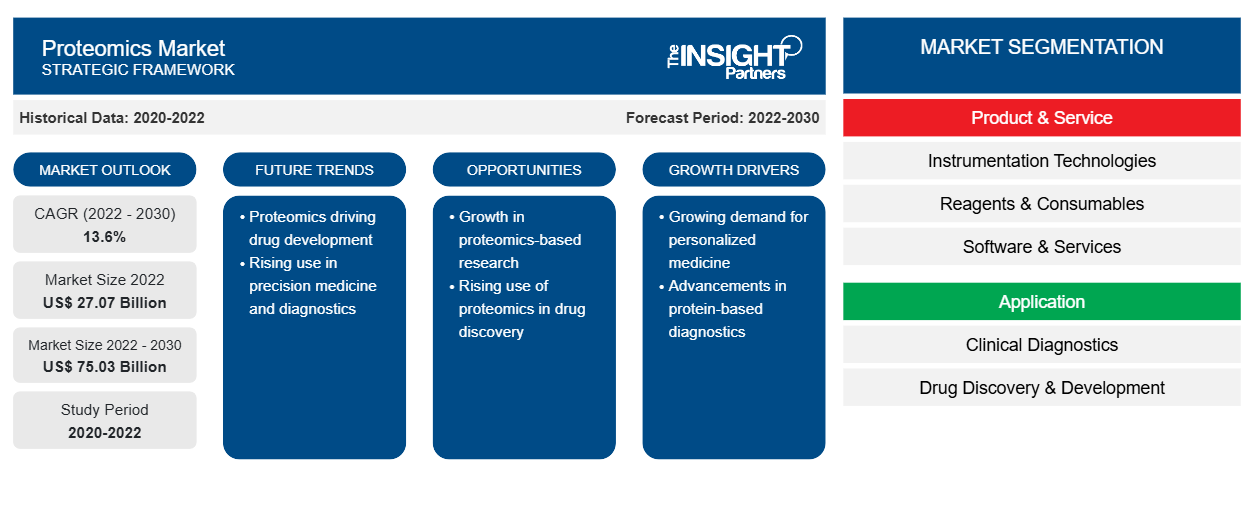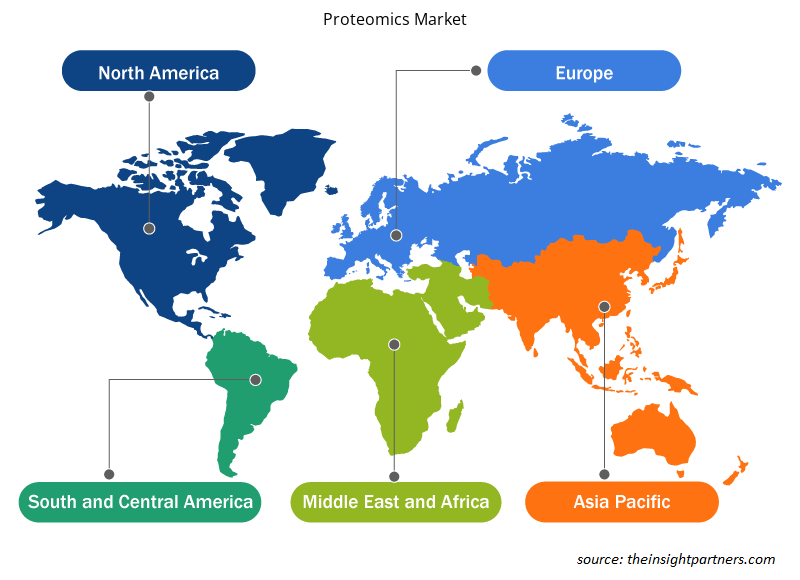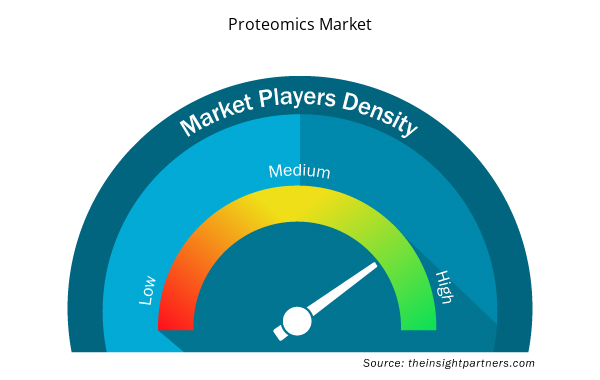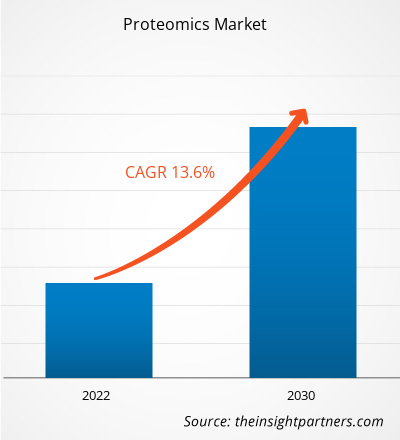The proteomics market size is projected to surge from US$ 34.56 billion in 2024 to US$ 85.91 billion by 2031; the market is estimated to record a CAGR of 11.9% during 2025-2031.
Analyst Perspective:
The report includes growth prospects owing to the current proteomics market trends and their foreseeable impact during the forecast period. Proteomics is the study of proteomes on a large scale. A set of proteins formed by a biological entity is known as a proteome. A proteome is not constant; it differs from cell to cell and changes over time. A proteome partially reflects the underlying transcriptome, which can also be defined as an organism's full range of messenger RNA molecules. Numerous factors influence protein activity in addition to the level of expression of a particular gene. Proteomics has numerous applications. Thus, the proteomics market is expected to grow considerably due to the increased demand for personalized medicines and increased research and development in proteomics. However, the strict regulatory requirements and dearth of skilled professionals hamper the market growth.
Market Overview:
The large-scale study of the structure and function of proteins is known as proteomics. It encompasses the rapidly evolving field of disease proteomics, which aims to identify proteins involved in human diseases and understand how their expression, structure, and function cause disease. Key factors driving the proteomics market growth include the increasing cases of cancer and other diseases. Ongoing research in proteomics can help doctors understand how proteins react in highly dynamic environments, such as in cancer patients. This is because proteomics obtains important information in the form of biomarkers. Furthermore, proteomics has proven to show significant progress. Additionally, the science of nano proteomics is expected to positively impact the market size in the coming years.
Customize This Report To Suit Your Requirement
You will get customization on any report - free of charge - including parts of this report, or country-level analysis, Excel Data pack, as well as avail great offers and discounts for start-ups & universities
Proteomics Market: Strategic Insights

- Get Top Key Market Trends of this report.This FREE sample will include data analysis, ranging from market trends to estimates and forecasts.
You will get customization on any report - free of charge - including parts of this report, or country-level analysis, Excel Data pack, as well as avail great offers and discounts for start-ups & universities
Proteomics Market: Strategic Insights

- Get Top Key Market Trends of this report.This FREE sample will include data analysis, ranging from market trends to estimates and forecasts.
Market Driver:
Increasing Cases of Chronic Diseases Propels Market Growth
The growing number of cases of chronic diseases such as cancer, respiratory diseases, chronic kidney disease (CKD), cardiovascular diseases (CVDs), and others is another factor expected to drive market growth. For example, according to Globocan, in December 2020, there were ~19.3 million new-found cancer cases worldwide, and 10 million cancer-related deaths were reported. Cardiovascular diseases are also one of the most common causes of death worldwide. For example, the WHO (2021) states that target diseases kill 41 million patients annually. Due to the increasing cases of life-threatening diseases, there is a growing demand for personalized therapies, which positively impacts the industry.
As a large number of populations around the world suffer from cancer, the need for treatments has increased significantly. Many discoveries are also being made in the field of life sciences. The characterization of human proteins is a milestone in biomedicine. Assessing gene expression at the proteome level is also important. Continuous research and development in this field will lead to significant growth in the proteomics market. This technique could provide extremely important biological information that will help understand the biology of cancer patients. Such growing cases of chronic diseases bolster the demand for proteomics.
Segmental Analysis:
The proteomics market analysis has been carried out by considering the following segments: product & service, application, and end user.
Based on product & service, the proteomics market is segmented into instrumentation technologies, reagents & consumables, and software & services. The reagents & consumables segment held the largest market share in 2022 and is estimated to register the highest CAGR of 14.1% during 2022–2030. During the forecast period, this value is likely to increase because of the growing use of reagents & kits, consumables, and strips for studying various biological materials in research universities, research institutions, and other areas. Increasing government initiatives to support the field of proteomics and genomics, as well as increasing research activities in disease diagnostics, will also drive the proteomics market growth. Additionally, technical advancements in advanced instruments, such as 3D electrophoresis protein analyzers, which increase biological research's speed, efficiency, and productivity, which will subsequently promote market expansion.
The market, based on application, is divided into clinical diagnostics, drug discovery & development, and others. The clinical diagnostics segment held the largest proteomics market share in 2022 due to researchers and clinicians' widespread use of protein analysis to identify disease biomarkers for early detection of risk factors. Also, it is possible to discover potential protein transcription regulation that can be used to identify and predict malignancies and evaluate their prognosis using proteomics-based diagnosis.
Based on end user, the proteomics market is divided into pharmaceutical & biotechnology companies, research & clinical laboratories, hospitals, and others. The pharmaceutical & biotechnology companies segment held the largest proteomics market share in 2022. However, the research & clinical laboratories segment is anticipated to register the highest CAGR of 14.5% during 2022–2030. Increasing R&D funding from pharmaceutical and biotechnology companies to develop novel drugs is expected to boost the demand for proteomics services. Additionally, the need for enzymes, reagents, and kits is fueled by increased research and development activities, several ongoing proteomics studies to treat various life-threatening diseases, and increased life science projects in research and academic settings.
Regional Analysis:
The scope of the proteomics market report includes North America, Europe, Asia Pacific, the Middle East & Africa, and South & Central America. The market in North America was valued at US$ 11.95 billion in 2022 and is projected to reach US$ 33.56 billion by 2030; it is expected to register a CAGR of 13.8% during 2022–2030. One of the key factors driving the market growth in this region is the increasing investments for the development of structure-based drug design, demand for high-quality research tools for data reproducibility, growth in omics research, etc. Attention is being paid to the development of tailor-made treatments. The partnerships and collaborations between major regional companies also contribute to this market expansion. For example, Thermo Fisher Scientific Inc. and Symphogen have collaborated to develop verified platform processes for optimized characterization and quality monitoring of complex therapeutic proteins. Several protein therapies are being tested in clinical trials to treat cancer, infections, immunological disorders, age-related diseases, and other problems. Additionally, proteomics research is at its peak in countries such as the US owing to the high incidence of inherited diseases such as Alzheimer's, as well as infectious diseases such as malaria and tuberculosis, in the region.
The Asia Pacific proteomics market is expected to record the fastest CAGR of 14.3%. The region, especially with countries such as India and China, is home to a sizable pharmaceutical industry. China is a pharmaceutical manufacturing hub. The projected market growth in this region is attributed to the availability of highly functional manufacturing units and contract manufacturing facilities in the region. Further, a huge population base susceptible to cancer and other infectious diseases, extensive use of proteomics in diagnosing genetic disorders, and increasing R&D spending and social programs are expected to propel the need for proteome-based disease diagnosis, thereby boosting the market growth.
Proteomics Market Regional Insights
The regional trends and factors influencing the Proteomics Market throughout the forecast period have been thoroughly explained by the analysts at Insight Partners. This section also discusses Proteomics Market segments and geography across North America, Europe, Asia Pacific, Middle East and Africa, and South and Central America.

- Get the Regional Specific Data for Proteomics Market
Proteomics Market Report Scope
| Report Attribute | Details |
|---|---|
| Market size in 2024 | US$ 34.56 Billion |
| Market Size by 2031 | US$ 85.91 Billion |
| Global CAGR (2025 - 2031) | 11.9% |
| Historical Data | 2021-2023 |
| Forecast period | 2025-2031 |
| Segments Covered |
By Product & Service
|
| Regions and Countries Covered | North America
|
| Market leaders and key company profiles |
Proteomics Market Players Density: Understanding Its Impact on Business Dynamics
The Proteomics Market is growing rapidly, driven by increasing end-user demand due to factors such as evolving consumer preferences, technological advancements, and greater awareness of the product's benefits. As demand rises, businesses are expanding their offerings, innovating to meet consumer needs, and capitalizing on emerging trends, which further fuels market growth.
Market players density refers to the distribution of firms or companies operating within a particular market or industry. It indicates how many competitors (market players) are present in a given market space relative to its size or total market value.
Major Companies operating in the Proteomics Market are:
- Proteome Sciences
- Biognosys
- Creative Proteomics
- Shantani
- Olink
- SomaLogic Operating Co., Inc.
Disclaimer: The companies listed above are not ranked in any particular order.

- Get the Proteomics Market top key players overview
Key Player Analysis:
Proteome Sciences; Biognosys; Creative Proteomics; Shantani; Olink; SomaLogic Operating Co., Inc.; QUANTUM-SI INCORPORATED; Proteomics International; Promise Proteomics; SCIEX; Illumina, Inc.; and Thermo Fisher Scientific Inc are among the key players profiled in the proteomics market report.
Recent Developments:
Companies operating in the proteomics market adopt mergers and acquisitions as key growth strategies. As per company press releases, a few recent market developments are listed below:
- In June 2022, SomaLogic and Illumina, Inc. announced a joint development agreement in which companies will utilize the SomaScan Proteomics Assay on Illumina's current and future high-throughput next-generation sequencing (NGS) platforms. The partnership accelerated next-generation sequencing in the proteomics market's fast-growing, ultra-high throughput workflow.
- In May 2022, Proteomics International Laboratories Ltd received US$ 13,516 in funding to enable the production of its PromarkerD clinical diagnostic in Australia, the world's first diagnostic, predictive test for diabetes-related kidney disease. The program aims to foster new health innovations, advance discoveries toward proof-of-concept and commercialization that address important health problems and maximize entrepreneurial and idea potential.
- Historical Analysis (2 Years), Base Year, Forecast (7 Years) with CAGR
- PEST and SWOT Analysis
- Market Size Value / Volume - Global, Regional, Country
- Industry and Competitive Landscape
- Excel Dataset


- Fixed-Base Operator Market
- Pharmacovigilance and Drug Safety Software Market
- Bio-Based Ethylene Market
- Digital Language Learning Market
- Photo Editing Software Market
- Sodium Bicarbonate Market
- Non-Emergency Medical Transportation Market
- Microplate Reader Market
- Environmental Consulting Service Market
- Intraoperative Neuromonitoring Market

Report Coverage
Revenue forecast, Company Analysis, Industry landscape, Growth factors, and Trends

Segment Covered
Product & Service, Application, End User, and Geography

Regional Scope
North America, Europe, Asia Pacific, Middle East & Africa, South & Central America

Country Scope
This text is related
to country scope.
Frequently Asked Questions
What is proteomics?
Proteomics, the detailed analysis of proteins, has become a significant field to study drug development, therapy, prognosis, and disease characterization. Proteomics technologies help with both infectious and noninfectious disease detection and therapy. The current proteomic methodologies are being made more reliable, biocompatible, specific, and reproducible through the use of nanotechnology as a technological platform. The shortcomings of conventional proteomic techniques are greatly assessed with the use of nanomaterials to enhance the quality of proteomic techniques by protein manipulation.
What was the estimated proteomics market size in 2024?
The proteomics market was valued at US$ 34.56 billion in 2024.
What are the driving factors for the proteomics market?
The factors driving the growth of the proteomics market include the proliferating cases of chronic diseases and growing prominence of nano proteomics.
Who are the major players in the proteomics market?
The proteomics market majorly consists of the players such as Proteome Sciences, Biognosys, Creative Proteomics, Shantani, Olink, SomaLogic Operating Co., Inc.; QUANTUM-SI INCORPORATED, Proteomics International, Promise Proteomics, SCIEX, Illumina, Inc.; and Thermo Fisher Scientific Inc.
What are the growth estimates for the proteomics market till 2031?
The proteomics market is expected to be valued at US$ 85.91 billion in 2031.
Which segment is dominating the proteomics market?
The global proteomics market, based on product & service is segmented into instrumentation technologies, reagents & consumables, and software & services. The reagents & consumables segment held a larger proteomics market share in 2024, and the same is predicted to register a higher CAGR of 11.9% during 2025–2031. Based on application, market is segmented into clinical diagnostics, drug discovery & development, and others. The clinical diagnostics segment held the largest proteomics market share in 2024. However, the drug discovery & development segment is estimated to register the highest CAGR of 11.9% during 2025–2031. Based on end user, the market is segmented into pharmaceutical & biotechnology companies, research & clinical laboratories, hospitals, others. The pharmaceutical & biotechnology companies segment held the largest proteomics market share in 2024. However, the research & clinical laboratories segment is estimated to register the highest CAGR of 11.9% during 2025–2031.
Trends and growth analysis reports related to Life Sciences : READ MORE..
The List of Companies - Proteomics Market
- Proteome Sciences
- Biognosys
- Creative Proteomics
- Shantani
- Olink
- SomaLogic Operating Co., Inc.
- QUANTUM-SI INCORPORATED
- Proteomics International
- Promise Proteomics
- SCIEX
- Illumina, Inc.
- Thermo Fisher Scientific Inc.

 Get Free Sample For
Get Free Sample For